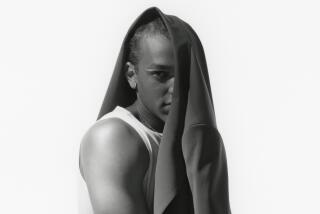SUITING YOURSELF: WHAT MEN SHOULD KNOW : SIZING up SUITS
So you want to buy a suit or sport coat but don’t want to get taken to the tailors?
Join the crowd. More than 3 million American men will brave the malls this fall in search of a suit. Their biggest fear? Buyers’ remorse, that nagging feeling that comes with a) spending too much; b) settling for a less than perfect fit; c) selecting a silhouette, color or pattern that’s incompatible with their personal taste or lifestyle; d) all of the above.
Some suits tagged as low as $199, for example, are as well made as higher-priced brand-name models (see related story) and even come from the same factories. Instead of cost, a suit--whether custom-made or off-the-rack--should be judged by the overall fit, the versatility and springiness of the fabric, and the construction. Watch out for such major flaws as fabric defects, puckered seams and subtle color differences between jackets and trousers.
While many salespeople will help you to avoid these pitfalls, others may try to charm and cajole you into making a poor choice. To separate the quality suits from the shabby, take the experts’ advice on:
FIT
“The first thing a guy should do is look in the mirror: Make sure the collar hugs the neck, the lapel lies flat and doesn’t buckle, the shoulder line is even, not wavy, and the coat hangs or drapes properly,” advises Norman Fryman, chief executive of the Greif Companies, a New York clothing manufacturer.
Sizing adjustments should be confined to the shortening of sleeves, the hemming of pants and the nipping of trouser waists. Such work should cost no more than $35, and many stores charge nothing. Keep looking, clothing makers advise, if a garment needs major reconstruction.
“Some stores will try to sell you a suit that is clearly too large by promising to lift the shoulder blades, cut the width and take in the center seam,” warns Tom Julian, fashion director for the New York-based Men’s Fashion Assn. “You’re probably looking at $120 in tailoring bills, which is absurd for a good suit.”
FABRICS
Suits may be made of worsted wool (flat fabrics such as twill and gabardine) or woolens (brushed cloths such as tweed and flannel), cotton seersucker, silk, linen, rayon, polyester and polyester blends. Some are built to last longer than others.
* All-worsted wools make the best year-round suits because the fabric breathes, keeping you cool in the summer and warm in the winter. Worsteds drape well, quickly bounce back when rumpled and hold their soft shape longer than most fabrics. New featherweight woolen flannels also have many of these desirable characteristics.
* A polyester-wool blend is ideal for men who are hard on clothing because it’s snag- and pill-resistant. The polyester minimizes wrinkling and the wool offers weight and warmth.
* Pure polyester suits may be less expensive, but they’re also less durable. The fabric quickly loses its shape, doesn’t breathe and tends to stick to the body.
* Lightweight cottons, silks, linens and rayons are perfect for warm weather. But because these fabrics wrinkle easily and deteriorate with each dry-cleaning, they’re not recommended for extended wear.
CONSTRUCTION
Whether constructed (as in more seams for a closer fit, smaller armholes for a sharper silhouette and a full, rather than partial, lining) or unconstructed, suits fall into two primary categories: fused or hand-finished. The latter tend to be more costly.
* In a fused garment, the two layers of fabric that make up the inside and outside of the jacket are glued rather than sewn together, giving it a somewhat stiff look. A simple test: If there is no sliding movement when you rub the jacket lapel between your thumb and finger, the garment is probably fused. A crackling sound indicates the glue has separated and the suit is no good. A completely machine-made, fused suit is not necessarily inferior to a hand-finished one.
* While the term hand-finished suggests that a suit is handmade, clothing makers let machines do most of the work, restricting hand-stitching to critical, high-pressure areas such as armholes, lapels, collars, buttonholes and sleeves. Handwork elsewhere means a softer-looking suit and a higher price tag. When pinching the lapel of a hand-finished suit, you should feel two layers of fabric.
Among the other ways to tell if a suit or sport coat is well made:
* Its seams have 12 or more stitches per inch. (Turn the jacket or trousers inside out, tug at a seam and count.)
* It has smooth, straight seams with a single row of stitching.
* The fabric pattern lines up at the seams.
* Buttons have a hand-finished shank on the inside for durability. (Machine-sewn buttons tend to fall off during dry cleaning.)
* Lapels extend about halfway between the collar and the shoulder line. Some designers cut lapels wider or narrower, depending on personal preference. When squeezed, lapels return to their original shape without wrinkles.
* Trousers are lined or half-lined to the knee.
CARE
* Use wooden or plastic contour hangers to retain suit shape.
* Unbutton jacket and empty pockets to avoid pulling of fabric.
* Leave plenty of space between hangers to avoid wrinkles caused by overcrowding.
* Allow suits to “rest” at least 24 hours between wearings to air out the fabric and relax wrinkles.
* Use a clothing brush to preserve the suit between dry cleanings.
WHAT TO LOOK FOR WHEN BUYING A SUIT
* Contoured jacket collar lays smoothly around the neck with no space between it and the shirt.
* Armholes are at least 9 inches in diameter to allow freedom of movement.
* Sleeves fall to the bottom of the wrist. Shirt sleeves peek out about a half-inch and remain clearly in view when the arm is bent.
* Side vents, usually 3 to 9 inches in length, align properly. Center vents are typically 7 to 9 inches long.
* Two-button jacket fastens at or slightly below the waist, about 24 1/2 inches from the back of the collar; the bottom button is undone. A three-button coat fastens at the top and center or the center only, and one with four or more buttons fastens either at the top only or everywhere except the bottom.
* Standard-size jacket is 31 inches long and falls to the palm. Some designers offer 32 1/2-inch coats for a softer, more casual look.
* Trousers follow the contour of the body. Standard width is 20 to 21 inches at the knee and ankles. Lengths vary: Some pants hit right at the shoe with no break in the fabric; others break once or even twice.
* Creased trousers are optional. High-end suits of late stress no crease.
* Cuffs are also optional. The extra bulk pulls the trouser leg down while retaining natural lines.
TIPS FROM THE EXPERTS . . .
1) SAMI DINAR, Beverly Hills retailer “When you take a suit or sport coat to the dry cleaners, always spend the extra $2 or $3 to have it hand-finished rather than run through the pressing machine. The pressing machine . . . causes the glue in a fused garment to separate, and it comes back puckered.”
*
2) ANDREW FEZZA, suit designer “A man should always have his trousers altered while wearing the shoes he plans to wear with the suit. . . . Also, he should make sure the tailor leaves enough seam allowance on the inside to lengthen the trousers in the future.”
*
3) TOM JULIAN, fashion director for the New York-based Men’s Fashion Assn. “If a man usually carries a small agenda in his breast pocket and/or a thick wallet in his pants pocket, he should be fitted (for a suit) with them. This way the garment doesn’t pull improperly because it was tailored too tight.”
*
4) ALAN FLUSSER, designer and author of “Clothes and the Man”: “If you spend $1,500 on a custom-made suit you’re actually getting more suit, more value for the money, than if you bought a ready-made suit for the same price. . . . With the ready-made suit you pay a 50% markup from both the designer and the store. You’re getting a suit that originally cost $350 to make. With a custom-made suit, you pay only the designer’s markup, (so) you’re getting a suit that cost about $750 to make.”
YOU GET WHAT YOU PAY FOR--OR DO YOU?
Some designer suits priced at $700 or more may wear no better than less expensive ones purchased from a discounter or at a super one-day sale. In fact, 70% of all suits and sport coats bought last year in the United States were markdowns, government statistics show. The average suit price: $135.
So let quality, not cost, be your guide to a well-made garment. The following elements generally characterize a suit tagged to sell for:
$99
* Usually imported from Eastern Europe, China or the Caribbean basin.
* Polyester, polyester-wool blends, other synthetic fibers. Coarse wool yarns used.
* 100% machine-made with fused (glued) chest panels, lapels and collar.
* Plastic or synthetic buttons.
* Non-mitered sleeve cuffs (similar to a shirt sleeve cuffs) that make alterations more difficult and more expensive.
* Unlined trousers.
* Inexpensive acetate linings in coats.
$300
* Both domestic and imported from Asia, the Caribbean, South America, Canada.
* All-worsted wools as well as polyester-wool blends. Softer, medium-grade wool yarns used.
* Machine-made, fused construction with some hand-sewing, particularly on collars and lapels.
* Plastic or synthetic buttons.
* Relatively easy to alter.
* Half-lined trousers, usually with a coin pocket and French fly front.
* Medium-quality acetate linings in coats.
$700+
* Most American, Italian, French and English designer labels as well as the better brand names.
* The finest and softest all-wool, two-ply worsted yarns, usually from Biella, Italy.
* Fully hand-tailored, with hand-sewn buttonholes, lapels, collars and armholes.
* Horn or other high-quality buttons.
* Easy to alter.
* Fully lined trousers with coin pocket and French fly front.
* Details such as additional inside pockets.
* 100% Bemberg linings in coats.
BODY TYPES
HEAVYWEIGHTS
Large men should avoid bold plaids, fitted jackets and vests. Vertical stripes and small herringbone patterns create the illusion of thinness, as do straight-hanging coats. “Double-breasted clothing is fine for a heavy man as long as he fastens the bottom button, which adds trimness and height,” suit designer Alan Flusser says.
LIGHTWEIGHTS
Tall, thin men can look good in any suit silhouette, and those under 5 feet, 8 inches “can now buy a double-breasted suit that has a lower button stance and longer roll of the lapel,” says suit designer Alan Flusser. “And (they) can wear any three-button coat with a long front line. Both give the illusion of height.”
MUSCLE MEN
The best bet for muscular men is an “athletic-fit” suit, a big seller in fitness-conscious California. It is designed to offer more slack to guys who are big in the chest, arms and thighs. Also, the trouser waist is smaller because such men tend to be more trim through the middle. The suit is widely available in department stores.
Source: Hart Schaffner & Marx, Chicago






